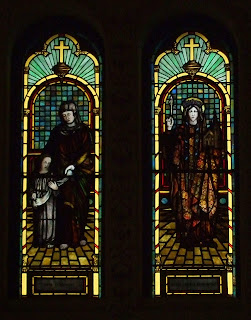At the beginning of the 20th Century, as parishioners from St. Albertus slowly moved away, Polish immigrants petitioned for another parish. In 1907, the parish of St. Hyacinth, known in Polish as Święty Jacka or Święty Jacek Odrowąż, was established with Fr. Sylvester Kolkiewicz as the founding pastor. The first Masses were held at the home of Martin Tesmar, one block south of the eventual, permanent site. The first church was built in only sixteen days, in December of 1907, and located where the parking lot is today.
A combination church and school was built in 1908 and it still stands today. Felician Sisters staffed the new school under the direction of the first principal, Sr. Mary Celine. The current church is dated to 1922 and was designed by the firm of Donaldson and Meier, architects of many Detroit churches.
Msgr. Stefan Woznicki was appointed pastor in 1936 and elevated to auxiliary bishop two years later. Despite his responsibilities as an active bishop, Woznicki maintained pastoral duties for the next fourteen years.
An outdoor Marian shrine, dated to 1966, commemorates 1,000 years of Christianity in Poland. In 1981, nearby Immaculate Conception was forced to close. After this, many of their parishioners moved to St. Hyacinth. The parish high school closed only ten years after the first graduating class. In 1990, the elementary school followed suit and the remaining Felician Sisters left the parish. To this day, the former school building is still used as a social hall.
In 2002, the church underwent a massive restoration. Major cleaning and repairs to the canvas, statues, walls and stained-glass windows were accomplished. The cost of the painting alone was $120,000.
The Sacred Heart of Jesus stands at the middle entrance, flanked by a Polish flag, a U.S. flag, and logo for Detroit's tricentennial.
The sanctuary is well-preserved and one of the most elaborate of any church in Detroit.
Fr. Janusz Iwan, a Polish-born priest, has served as pastor since 2006.
The Last Supper is engraved on the facade of the freestanding altar.
Three cupolas are found in the ceiling of the nave, each showing particular saints around the perimeter.
Icons of saints, particularly the evangelists, surround each cupola. Corinthian columns line the side aisles.
Reflecting their Polish heritage, images of Our Lady of Częstochowa and Pope St. John Paul II appear in front of the left side altar.
St. Joseph, St. Francis of Assisi, and St. Anthony of Padua also stand at the same shrine.
A large crucifix and Infant of Prague stand near the right altar.
St. Stanislaus, a martyr and the first Polish-born bishop, appears in the left side of the nave near a Marian shrine.
St. Maximilian Kolbe appears in the right side of the nave, near a shrine to the parish's patron.
Dennis Orlowski, a local artist of Polish descent, was commissioned to paint a mural depicting the Polish ancestry of the parish. On one side, it shows historic Polish churches of the Poleton neighborhood. Another side depicts Polish customs such as a Wigilia.
St. Hyacinth is regularly included in historic church tours and was the first to host the Detroit Mass Mob.
The parish has some unique, annual traditions. In the spring of each year, St. Hyacinth hosts a Mass to celebrate Polish for dance groups with as many as 200 dancers in attendance. The parish "Banana Festival" is held the first weekend of October every year.
The parish website includes a robust history report and detail hagiography of the patron.
We previously featured St. Hyacinth three years ago.







































No comments:
Post a Comment